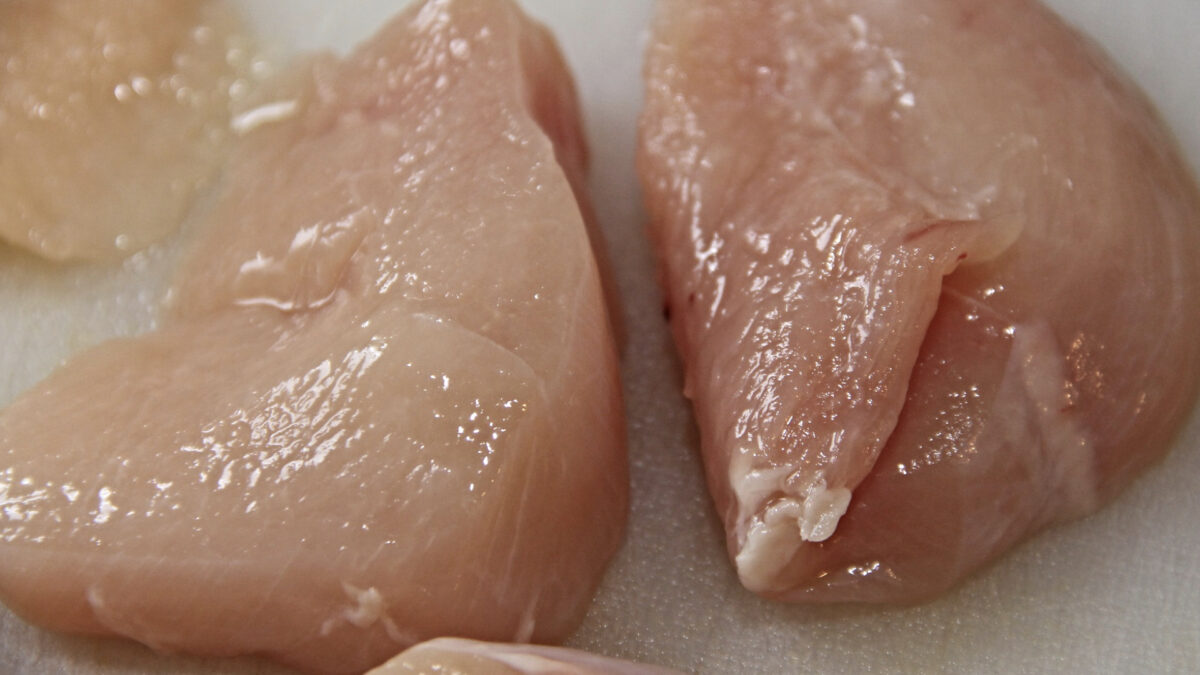Poultry is the most common cause of serious food-poisoning outbreaks, followed by fish, then beef. But aren’t people more likely to order their burgers rarer than their chicken sandwiches? The primary location where outbreaks occur is the home, not restaurants.
In 2017, a study of more than a thousand food-poisoning outbreaks determined that poultry, specifically chicken, was the most common culprit, “highlight[ing] the role of poultry as a major source of foodborne outbreaks in the United States.” Fish was the second “most frequently reported food category,” and beef was third. But aren’t people more likely to order rare burgers than rare chicken sandwiches? Yes. The biggest problem with poultry isn’t “inadequate cooking,” but “food-handling errors,” both at home and in the grocery store.
As I discuss in my video How to Shop for, Handle, and Store Chicken, a “shop-along observational study was conducted to determine actual shopping, transportation, and storage behavior of consumers who purchase raw poultry products.” What did the researchers find? “Neither hand sanitizer nor wipes were observed in 71% of grocery store meat sections of stores visited.” Even when sanitizing products were available, only one participant out of the 96 they followed used them. Food-poisoning bacteria can get on the outside of packages, “therefore, it also is important to educate shoppers on the importance of using hand sanitizer in the meat section after touching poultry packages.” Plastic bags were available in most meat sections, “but only 25% of shoppers used the bag for their raw poultry purchases…The shoppers placed the poultry [directly] in the main basket of the grocery cart 84% of the time,” where it could come in direct contact with fresh produce that might then be eaten raw in a salad, for example.
After the shoppers put the poultry in the basket, where did their hands go? Without using any kind of sanitizer, most shoppers then grabbed the handle of the cart. “Because shoppers are not practicing good hand hygiene when handling poultry in the grocery store meat section, they could contaminate a variety of items as a result of contact with their hands. Contact with other products occurred frequently in the cart, which could result in cross-contamination. Touching the cart after directly handling the poultry packages could potentially mean that the cart is a risk factor for Salmonella or Campylobacter. The bacteria potentially left on the cart could affect other shoppers, not just the participant being observed.” So, some kale shopper following all the safety precautions can come along and still be exposed to poultry contamination via the grocery cart.
In addition to touching the cart, poultry shoppers may also touch a personal item after touching a raw poultry package. A personal item could even include their children. In fact, as you can see below and at 2:29 in my video, after touching poultry packages, 31 percent of shoppers touched a personal item, like their purse or their child.

Most shoppers left the store with poultry separated in its own bag, “however, most consumers then took it out of this protective layer” when they got home. One in three placed the poultry package directly on the counter before it went into the fridge, and most shoppers “stored raw poultry in the original package without an additional container or overwrap,” where it could potentially come into contact with other items. Fewer than one in five “consumers correctly stored raw poultry…on the bottom shelf of their refrigerators in a sealed container or plastic bag.” Why the bottom shelf? Because if the “raw juices” leak, they could contaminate other foods.
The next mistake most people make is washing or rinsing raw poultry before cooking it. Up to 90 percent of people say they wash their chicken before cooking it, because that’s what they’re used to and “because they want to ‘rinse the slime off of just-opened chicken….’” The problem is that “when poultry is washed or rinsed, ‘splashing’ of contaminated water can travel” throughout a roughly two-foot halo, splattering slime on either side and in front of the sink. And, even though a lot of folks read or heard you weren’t supposed to wash raw poultry, they continued to do it anyway.
Fewer than about one in ten people thaw frozen poultry properly—that is, “put the raw poultry in a sealed container or plastic bag, submerge it in cold water, and change the water every 30 mins per the USDA’s recommendation.” And if you’re wondering whether it’s better to put raw poultry on a wood or plastic cutting board, neither is safe, because both get rapidly contaminated.
“Failure to use a food thermometer is [another] potentially unsafe practice, given that 70% of chicken pieces that were judged by consumers as ‘done’ had not reached safe internal cooking temperatures according to a summary of food safety literature.” In focus groups, “many participants thought food thermometers were unnecessary to determine whether meat and poultry was ‘cooked thoroughly” because they had been ‘cooking for years without once getting food poisoning,’” but had they ever come down with what they thought was a 24-hour flu? There’s no such thing as a 24-hour flu! That was likely food poisoning. Actually, any stomach bug or stomach flu is most likely food poisoning. Ever have a urinary tract infection? There are “multiple lines of evidence indicating poultry as a major food animal reservoir for urinary tract infection” bacteria that lie in wait in the rectum and then crawl up.
More than a million foodborne Salmonella and Campylobacter infections are reported each year in the United States. “Although half of Americans think it is ‘not very common’ for people in the United States to get foodborne illness because of the way food is prepared in their home, food safety experts estimate that the home is the primary location where foodborne disease outbreaks occur.”
